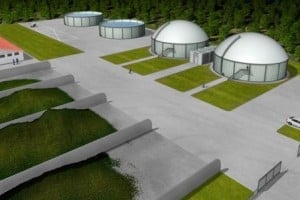A methane digester (anaerobic manure digester) converts the energy stored in livestock waste to methane (or biogas), which can produce renewable energy.
EPA mandate 40 CFR Part 98 Subpart JJ
Facilities emitting 25,000 metric tons of CO2e per year are required by the EPA to report annual GHG emissions per EPA mandate 40 CFR Part 98. Subpart JJ covers reporting for manure management systems utilized by farming operations and landfills.
Subpart JJ covers all facets of manure management systems, which stabilize or store livestock manure in at least one of the following: uncovered anaerobic lagoons; liquid/slurry systems with and without crust cover (including but not limited to ponds and tanks); storage pits; digesters, including covered anaerobic lagoons; solid manure storage, drylots, including feedlots; high-rise houses for poultry production (poultry without litter); poultry production with litter; deep bedding systems for cattle and swine; manure composting.
Biogas or Digester Gas from Farming Operations
Biogas is produced from organic matter. It can be derived from fermentation or anaerobic digestion processes (digester gas) from an organic feedstock, such as manure, sewage, agricultural waste, municipal waste, biomass, and industrial waste from food and beverage manufacturers. Biogas is a blend of approximately 65% CH4 and 35% CO2. Methane traps heat in the atmosphere over 20 times more than carbon dioxide and remain in the atmosphere for nine to fifteen years.

Digester gas from farming and other agricultural operations is generated from the breakdown of livestock waste when the gas is captured within a large plastic cover, known as a digester. The manure decomposes in the absence of oxygen (anaerobic digestion). Typically, the decomposition of livestock waste results in vast amounts of methane, which vents naturally to the atmosphere.
When biogas is captured, it can be used to create energy while simultaneously reducing greenhouse gas emissions to improve the environment. Among the industries producing methane include farming operations and landfills.
Methane Destruction
The digester creates biogas or digester gas, a mixture of approximately 65% methane (CH4) and 35% carbon dioxide (CO2). This gas can then be captured and destroyed in a process called methane destruction, which is accomplished by burning the gas in a flare or an engine. While the process creates carbon dioxide (a greenhouse gas), methane destruction can ultimately reduce GHG emissions since methane is 21 times more potent than carbon dioxide.
Renewable Energy
Digester gas can also provide a source of fuel for heating or generating electricity. Hundreds of farming operations reduce GHG emissions, accrue emissions credits to meet EPA’s reporting standards, and create renewable energy.
Sage Meter Excels
Thermal mass flow meters can quantify the emissions saved by measuring the mass flow rate. Since the environment is challenging and there are varying flow rates, many other flow technologies are unsuitable. The SAGE meter has a rangeability of at least 100:1 and as high as 1000:1, making it highly accurate over a wide flow range, which is needed because of gas spikes and seasonal climate changes. The SAGE sensors are clad in protective 316 SS sheath and protect against corrosion.
The Sage Prime and Paramount excels in these applications:
- They have low-end sensitivity making them accurate at very low flows.
- The easy in-situ calibration verification procedure complies with EPA requirements.
You may be interested in:

